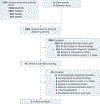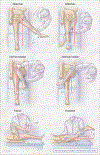Does This Patient Have Hip Osteoarthritis?: The Rational Clinical Examination Systematic Review
- PMID: 31846019
- PMCID: PMC7583647
- DOI: 10.1001/jama.2019.19413
Does This Patient Have Hip Osteoarthritis?: The Rational Clinical Examination Systematic Review
Abstract
Importance: Hip osteoarthritis (OA) is a common cause of pain and disability.
Objective: To identify the clinical findings that are most strongly associated with hip OA.
Data sources: Systematic search of MEDLINE, PubMed, EMBASE, and CINAHL from inception until November 2019.
Study selection: Included studies (1) quantified the accuracy of clinical findings (history, physical examination, or simple tests) and (2) used plain radiographs as the reference standard for diagnosing hip OA.
Data extraction and synthesis: Studies were assigned levels of evidence using the Rational Clinical Examination scale and assessed for risk of bias using the Quality Assessment of Diagnostic Accuracy Studies tool. Data were extracted using individual hips as the unit of analysis and only pooled when findings were reported in 3 or more studies.
Main outcomes and measures: Sensitivity, specificity, and likelihood ratios (LRs).
Results: Six studies were included, with data from 1110 patients and 1324 hips, of which 509 (38%) showed radiographic evidence of OA. Among patients presenting to primary care physicians with hip or groin pain, the affected hip showed radiographic evidence of OA in 34% of cases. A family history of OA, personal history of knee OA, or pain on climbing stairs or walking up slopes all had LRs of 2.1 (sensitivity range, 33%-68%; specificity range, 68%-84%; broadest LR range: 95% CI, 1.1-3.8). To identify patients most likely to have OA, the most useful findings were squat causing posterior pain (sensitivity, 24%; specificity, 96%; LR, 6.1 [95% CI, 1.3-29]), groin pain on passive abduction or adduction (sensitivity, 33%; specificity, 94%; LR, 5.7 [95% CI, 1.6-20]), abductor weakness (sensitivity, 44%; specificity, 90%; LR, 4.5 [95% CI, 2.4-8.4]), and decreased passive hip adduction (sensitivity, 80%; specificity, 81%; LR, 4.2 [95% CI, 3.0-6.0]) or internal rotation (sensitivity, 66%; specificity, 79%; LR, 3.2 [95% CI, 1.7-6.0]) as measured by a goniometer or compared with the contralateral leg. The presence of normal passive hip adduction was most useful for suggesting the absence of OA (negative LR, 0.25 [95% CI, 0.11-0.54]).
Conclusions and relevance: Simple tests of hip motion and observing for pain during that motion were helpful in distinguishing patients most likely to have OA on plain radiography from those who will not. A combination of findings efficiently detects those most likely to have severe hip OA.
Conflict of interest statement
Figures





References
Publication types
MeSH terms
Grants and funding
LinkOut - more resources
Full Text Sources
Medical

